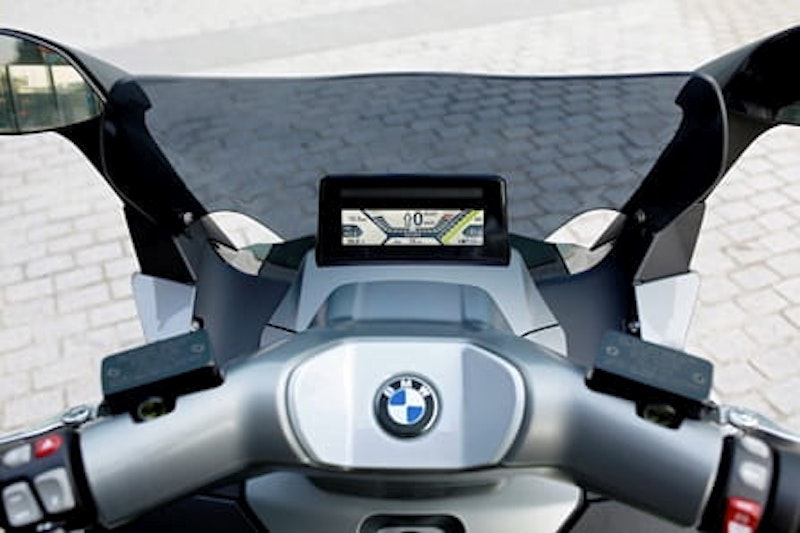Author: Roland Brown Posted: 05 May 2014
Riding a scooter for 40 miles on a mix of city streets, occasional twisty roads and a short stretch of motorway wouldn’t normally be all that much to shout about. It is when that scooter is BMW’s electric C evolution, when it’s covered the distance at an impressive pace of up to 70mph — and, most of all, when its instrument panel is showing enough juice left for another 20 miles.
Electric bikes have so far struggled to make any sort of impact, at least in the UK, but as the first battery-powered two-wheeler from a major manufacturer the C evolution is arguably the biggest step forward yet. More to the point, on the basis of this first launch ride around Barcelona it’s good enough — and keeps going for long enough — to attract a significant following.
At first sight the C evo looks much like a normal big scooter, apart from the distinctive white and electric green that is the only colour scheme. But beneath the bodywork is a large aluminium box that acts as the frame, with the front fork assembly and diagonally mounted rear shock bolted to it. And this box also holds the lithium ion batteries — three of the eight cells that are used by BMW’s recently released i3 car.
Official rating of the liquid-cooled electric motor is 15bhp, meaning the C evo can be ridden on an A1 licence. But that output is misleading — in a good sense. Its max for homologation purposes is 15bhp but in normal use the evo makes 47.5bhp, enough for an electrically limited top speed of 75mph. That means it’s rapid for a scooter — just as quick as BMW’s conventional C600 and 650 scoots as it surges smoothly forward in almost eerie silence, the only sounds a slight whine and the wind coming over the low screen.
There are four riding modes, easily selected with a button on the right bar, and very distinct:
Road gives an average amount of engine braking and regeneration
Dynamic gives more of both
Sail mode hardly any (like a two-stroke, the BMW barely slows when you shut the throttle)
Eco Pro adds range but reduces performance so is really just for when the battery’s running low
Handling is very good, with well damped and fairly firm suspension helping to make the C evo, which weighs a hefty 265kg, go round corners respectably well. It has powerful ABS-equipped brakes with twin discs up front, and enough ground clearance to give its Pirelli Diablo Scooter tyres a decent workout. There’s even a traction control system.
Equally importantly its claimed range of just over 60 miles in normal riding does seem accurate (at least on a warm day when the batteries are new), and is enough to make the C evo a practical proposition for plenty of people. This is far further than many riders commute, and the BMW helps by having a very accurate gauge to tell you what percentage of charge, and more importantly how much range, you have left.
It’s not all good news. There’s only room under the seat for an open-face lid, the price of £13,500 is high, and plans for a network of charging points are nowhere near reaching reality. But running costs are laughably low (a full charge takes four hours and should cost less than £2.00), and the performance is definitely good enough to put a smile on your face. Looks like the long awaited electric bike revolution finally starts right here.
+ Points — Acceleration, handling, low running costs, green factor
- Points — Price, lack of storage, few charging points, range an issue for some
Photos:Peter Musch
Share on social media:

